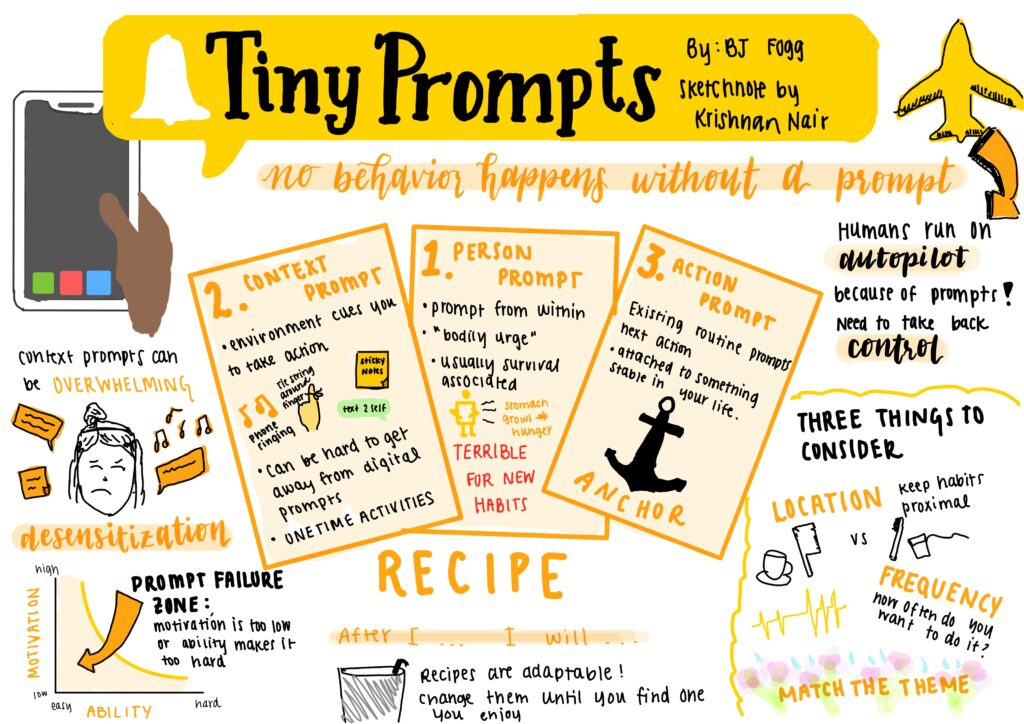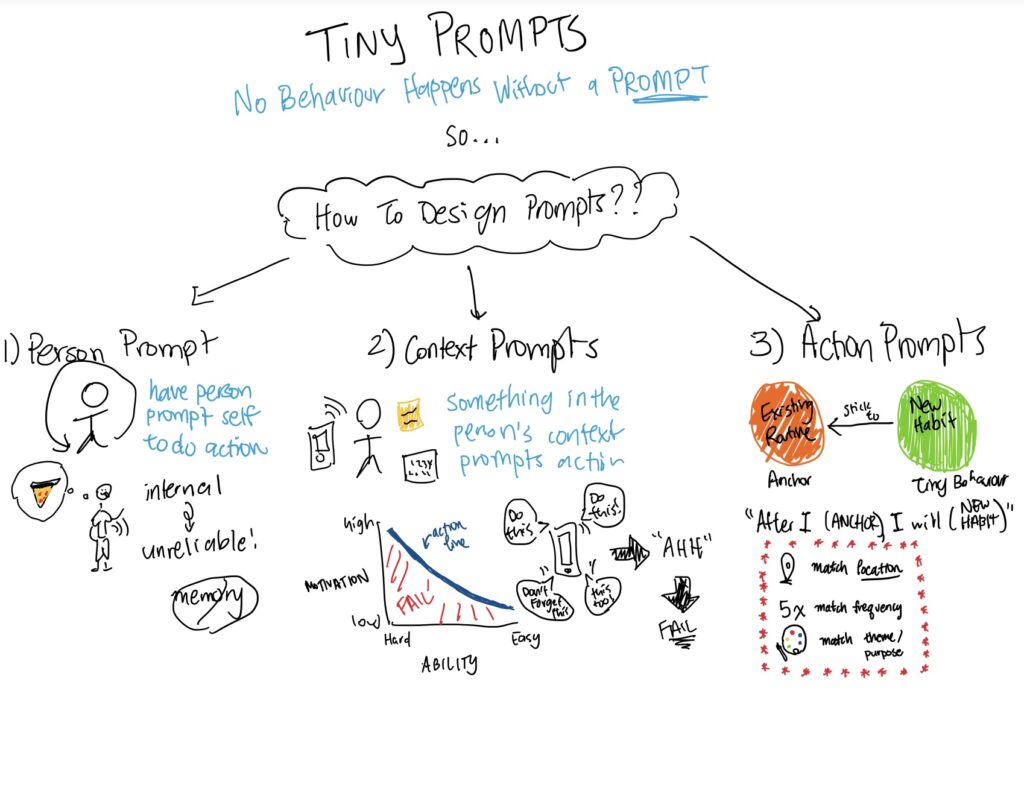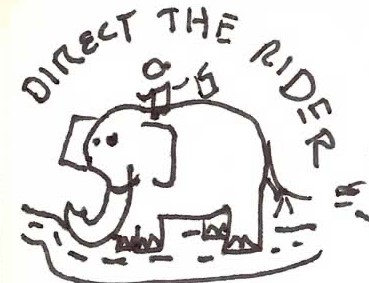Team 12: Griffin Somaratne, Jianna So, German Enik, Dana Chiueh
TLDR:
Due to the absence of any apps that target individual food waste, we looked into apps that focus on domestic and commercial food waste. Grocery stores and restaurants have the ability to sell unsold food at discounted prices, and consumers can track their groceries to prevent repeat purchases and spoilage.
Though many features in these apps are not directly applicable to our problem domain, they do provide possible idea for our product and its user experience. We must factor in that each person has different caloric needs, so encouraging thoughtful portion sizes should provide guidance that fits the user. Any sort of logging should be frictionless and reduce cognitive load for the user by using tools such as the camera to scan or photograph. Lastly, quantifying users’ behavior in the app is an exciting way to share individual impact.
Our team is focusing on food waste in dining halls and users who want to reduce their individual waste behavior. When conducting comparative research, we found that most apps targeting food waste focus on waste in homes (through spoiled groceries) or restaurants (through thrown out unsold food). They encourage more sustainable grocery shopping, keep track of what’s in your fridge, sell unsold food from restaurants at a discounted price, and give food away to those in need. There is a single app that targets food waste on college campuses (at LeHigh University), but it focuses on connecting hungry students to leftover food from club events and has not been released.
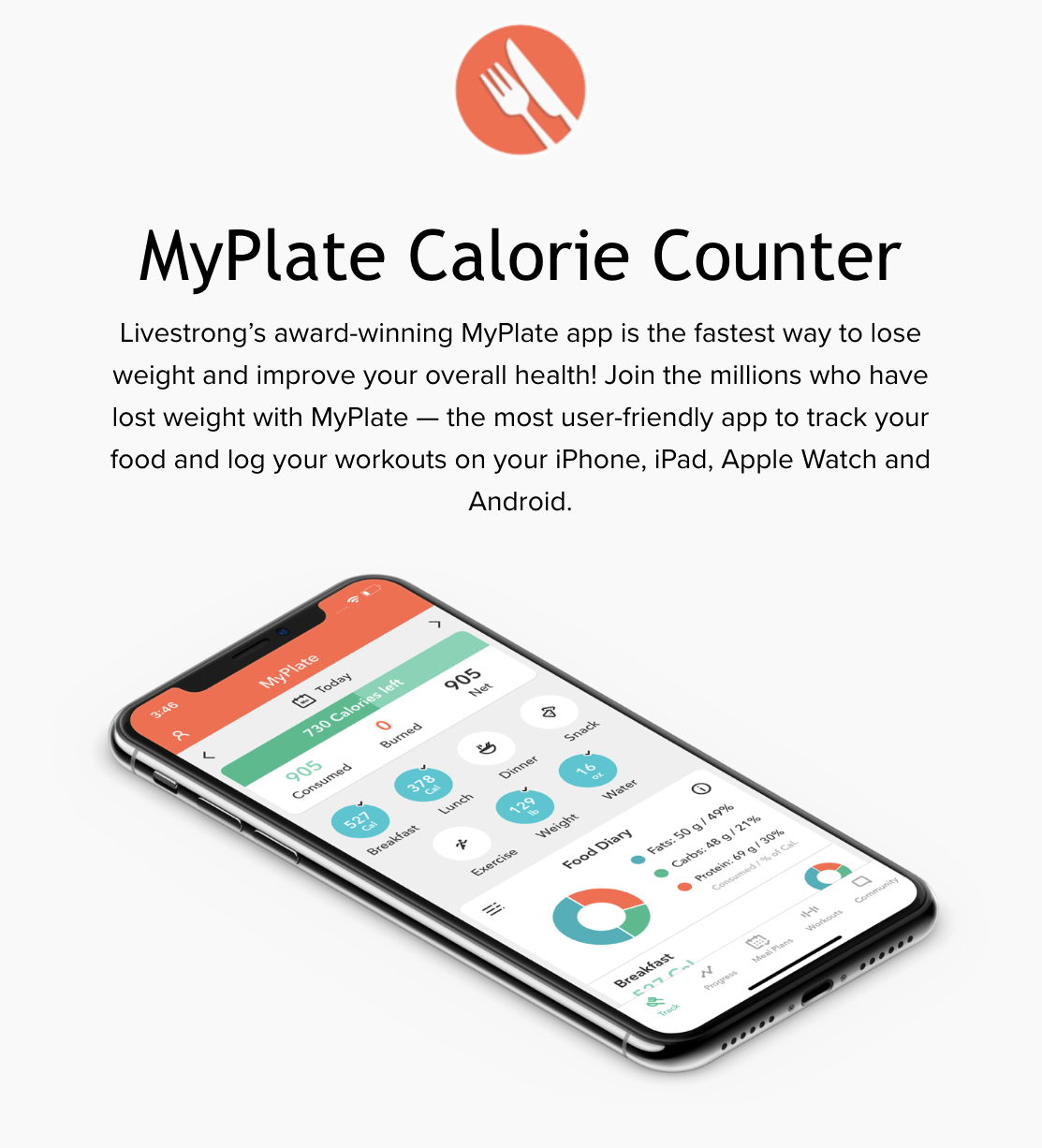
Although we are not solving the problem of weight loss, we were curious to look into logging-based food-related applications.
Description: This mobile app offers food & fitness logging functionality. They used the world’s largest food database to easily estimate calorie amounts for queried food items. The app also offers a rich variety of charts tracking the user’s progress and nutrient breakdowns. It also has inter-device integration, which makes food tracking easier–for example, in case the user is not near their phone, they can use their watch. The app offers a community of users to motivate each other. Lastly, when unsure what to eat, MyPlate Calorie Counter can suggest a food to eat. This app won the 2018 people’s voice award.
Audience: This app addresses two subgroups of audiences:
- Those interested in losing / gaining / maintaining their weight via calories.
- Those interested in keeping track of consumed nutrients.
Indirectly, this app also targets technologically informed users who are comfortable using their phone for small tasks.
Strengths: pleasant user interface, inter-device integration, large food database, diverse visual display of accumulated statistics, social aspect via in-app community, recipe suggestions (most elaborated in product description).
Weaknesses: While the app attempts to make the experience seamless, some reviewers still find the act of logging calories cumbersome and tiring. App store reviews also point out that measurements in terms of “one carrot” / “one medium egg”, which is too vague for calorie counting. Others also point out a few engineering bugs and unintuitive experience to create a custom food.
Takeaways: If fit for our future solution, we will consider avoiding manual logging and incorporating camera use for food waste. If we do pursue logging, will also consider non-numeric logic (e.g. selecting graphics).

This app addresses domestic food waste which has differences from dining hall waste, yet it is still very related!
Description: This app lets its users track groceries bought, eaten, and thrown out. It also lets the users track their food waste by deleting their food as eaten or expired, follow their monthly food waste & savings. Additionally, users can follow the community’s food waste and savings and stay cognizant of foods that have a high waste risk.
Audience: This products targets a few groups of users based on reading user reviews:
- Environmentally conscious people who are motivated to decrease their own food waste. We discovered this app on a blog of an zero-waste advocate: https://www.almostzerowaste.com/.
- People on a budget and those conscious of spending. This app can help people spend less by first finishing what they have bought.
Strengths: Simplicity of a user interface, numeric data, multiple target audiences (most elaborated in product description).
Weaknesses: A minor weakness is that this app does not have many food entries, which is not a huge deal breaker because no calorie tracking gets performed, and the app seems lighter and simpler this way. Another weakness is the requirement to log everything manually (as opposed to snapping a photo of the receipt).
Takeaways: Keep application / solution relatively light-weight in order to not add too much overhead into users’ lives (since our project concerns habitual, regular activity).
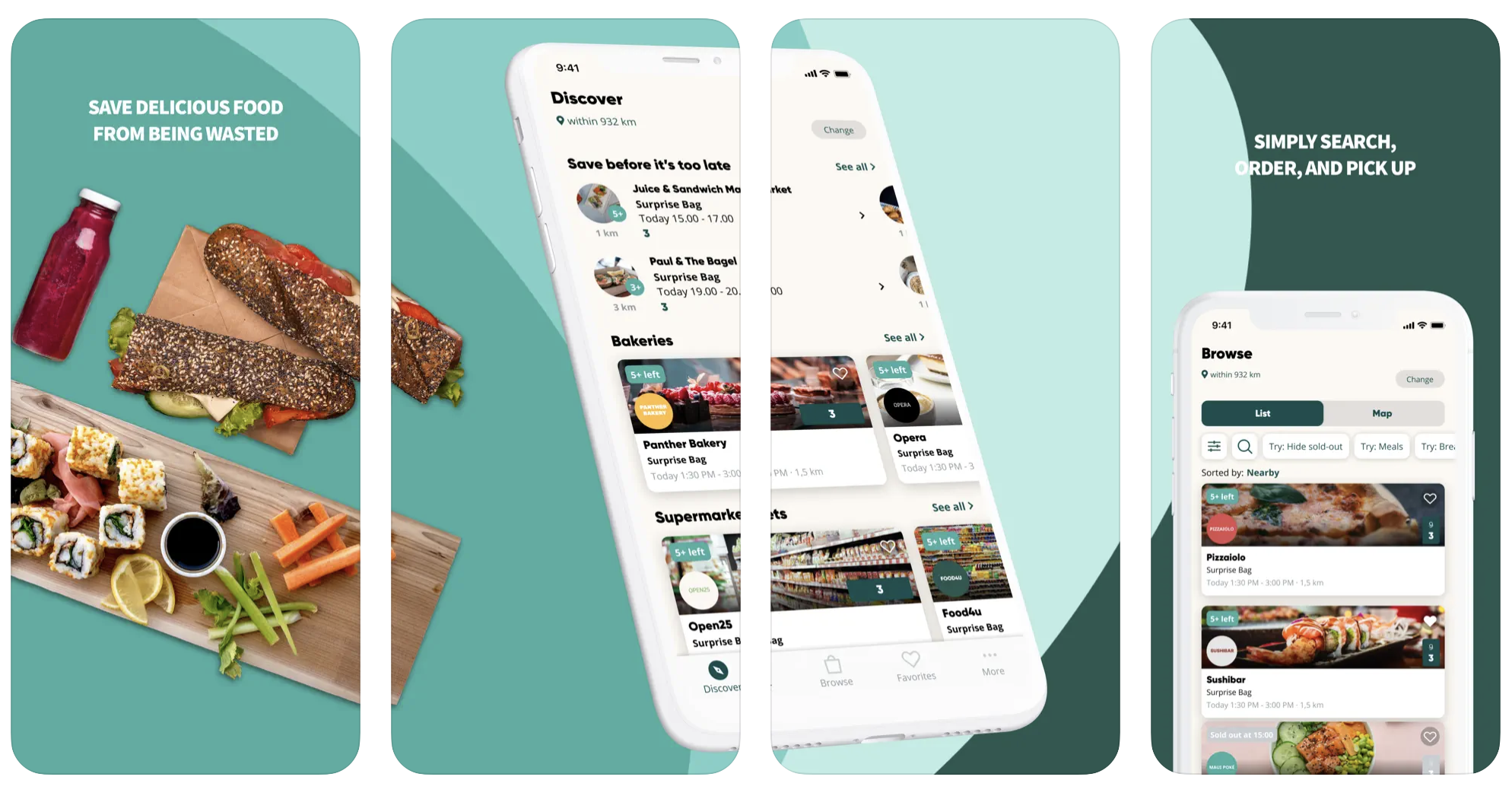
Description: Users can buy “Surprise Bags” of surplus food at discounted prices from businesses, including bakeries, grocery stores, and restaurants. It aims to reduce the “third” of food that is currently wasted in bigger food production situations.
Audience:
- Businesses with surplus food: They can recover sunk costs while reaching new customers, and make use of the ingredients and labor that went into making the perfectly consumable food they have left at the end of the day.
- Adventurous eaters on a budget: They can try new food at a lower price, as long as they’re okay with a bit of mystery and unplanned meals.
Value add: Most interestingly, Too Good to Go capitalizes on an element of intrigue, wonder, and delight. The concept of a “Surprise Bag” is often applied to toys, not meals. This makes the idea of buying random food more appealing to users. Its focus on business food waste, which is large scale and completely illogical, makes it an easy sustainability cause to support. Plus, for users, they don’t have to think much about making a choice regarding their meal.
Strengths: This app is amazingly simple, on both ends of the experience. The specialized task (buying and selling surplus food without much choice) creates a seamless flow that makes it easy to practice sustainability and support local vendors.
Weaknesses: Not a ton of user agency, since “Surprise Bags” are complete surprises, save for any dietary restrictions.
Takeaways: Sustainability can be (and should be) fun! This app is quite novel in its approach– it depends on the moral benefit of sustainable food consumption, and makes it easy to support by providing businesses and customers with simple choices to provide or make along the way.
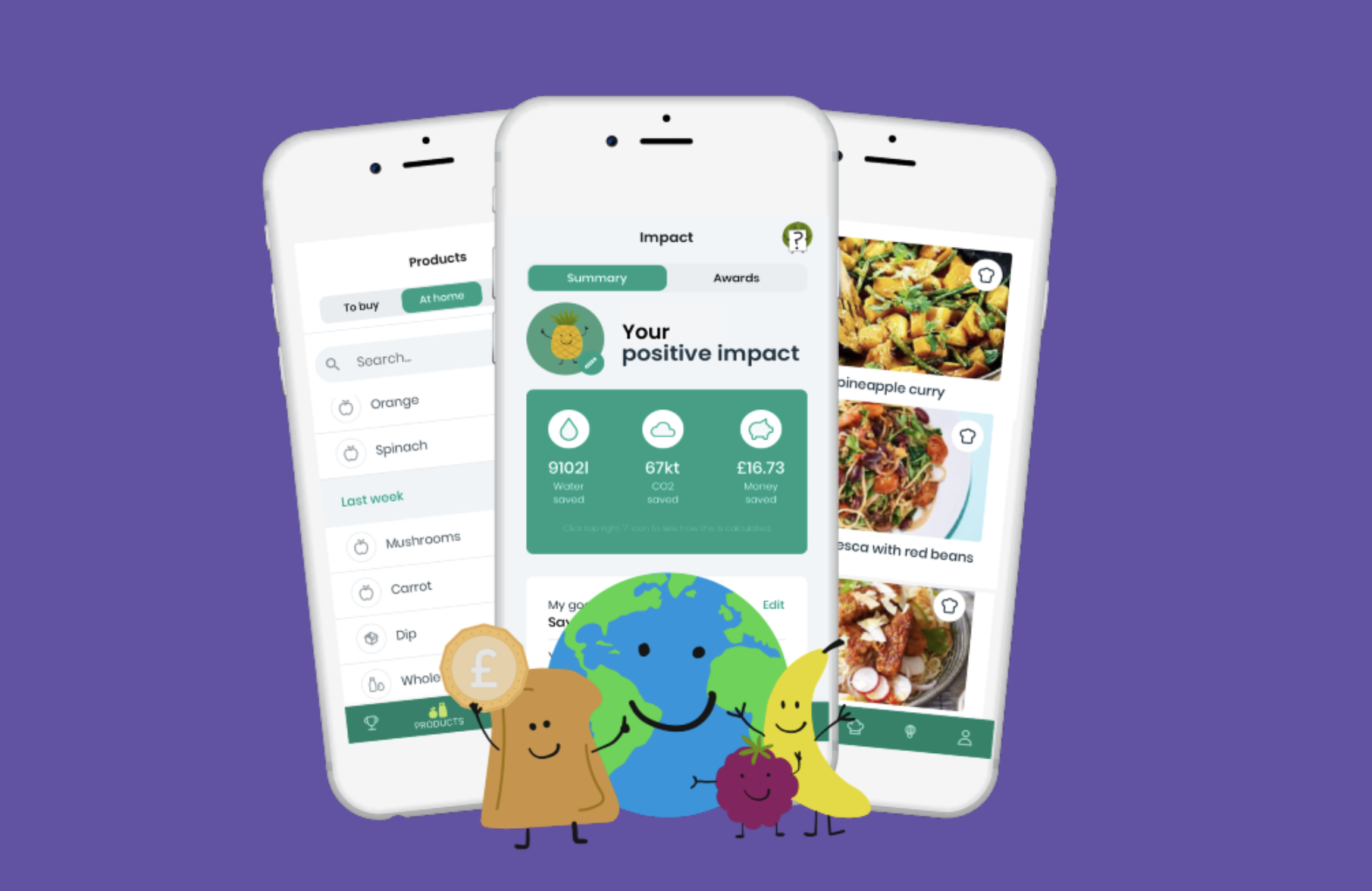
Description: Kitche users can input the food they have at home manually and by scanning their grocery store receipts. Kitche aims to reduce food waste and make grocery shopping more sustainable by preventing repeat purchases and spoiled food. The app provides recipes for the food users have on hand, reminds them when it is time to eat their food, and calculates the environmental impact of their actions.
Audience:
- Environmentally conscious people who are motivated to decrease their food waste and/or the impact of wasted food (water usage and carbon dioxide emissions)
- People looking to save money and food by eating their groceries before they expire and only buying what they need
Value add: By scanning grocery receipts, sending expiration reminders, and suggesting recipes, Kitche significantly reduces the cognitive load required for users to inventory their groceries, figure out how to use them, and use them before they go bad. The Impact and Awards sections both add joy and intrigue to the experience by tracking how much money, water, and carbon dioxide they save and celebrating users’ achievements.
Strengths: The app interface is intuitive, with each section having a separate function to reduce food waste and save money. Estimating the positive impact of users’ behavior is a great motivator, and the receipt scan feature (if effective) is the key differentiator and strength of the app.
Weaknesses: The app is currently unavailable in the US :’) User reviews mention developer errors such as leaving out an option for year and a calendar view selection for expiration date. Also, there is no form of sharing between members of a household. Still need to tick off when food has been used.
Takeaways: Reducing cognitive load and effort required of the user is the most attractive feature. Quantifying users’ behavior in the app is an exciting way to share their individual impact.
Description: Similar to Too Good to Go, this app helps users find discounted food at grocery chains near them. Shoppers browse the app for food items, purchase them in the app, then pick up their order at the store. The app prevents food waste by selling items approaching their best before date at 50% their price before they are thrown out.
Audience:
- Grocers that frequently throw out food items within two weeks of their best before dates
- Shoppers who are looking to reduce food waste for environmental or other reasons
- Shoppers looking for discounted food items, ranging from produce to meat to packaged goods
Value add: Flashfood’s differentiator is the discount its grocers offer — up to 50% off of any food item approaching its best before date.
Strengths: The service is a great idea that helps shoppers save money and helps grocers reduce food waste. The order process seems relatively intuitive.
Weaknesses: The service as a whole has spotty quality. The app reviews feature a few anecdotes about less than understanding grocery workers or incorrect/missing items in their order.
Takeaways: Financial incentive is an effective way for people to reduce food waste without thinking about it very much. Though the app is to reduce commercial food waste, the partnership between grocery stores and the platform could inspire relationships between our intervention and the dining halls.
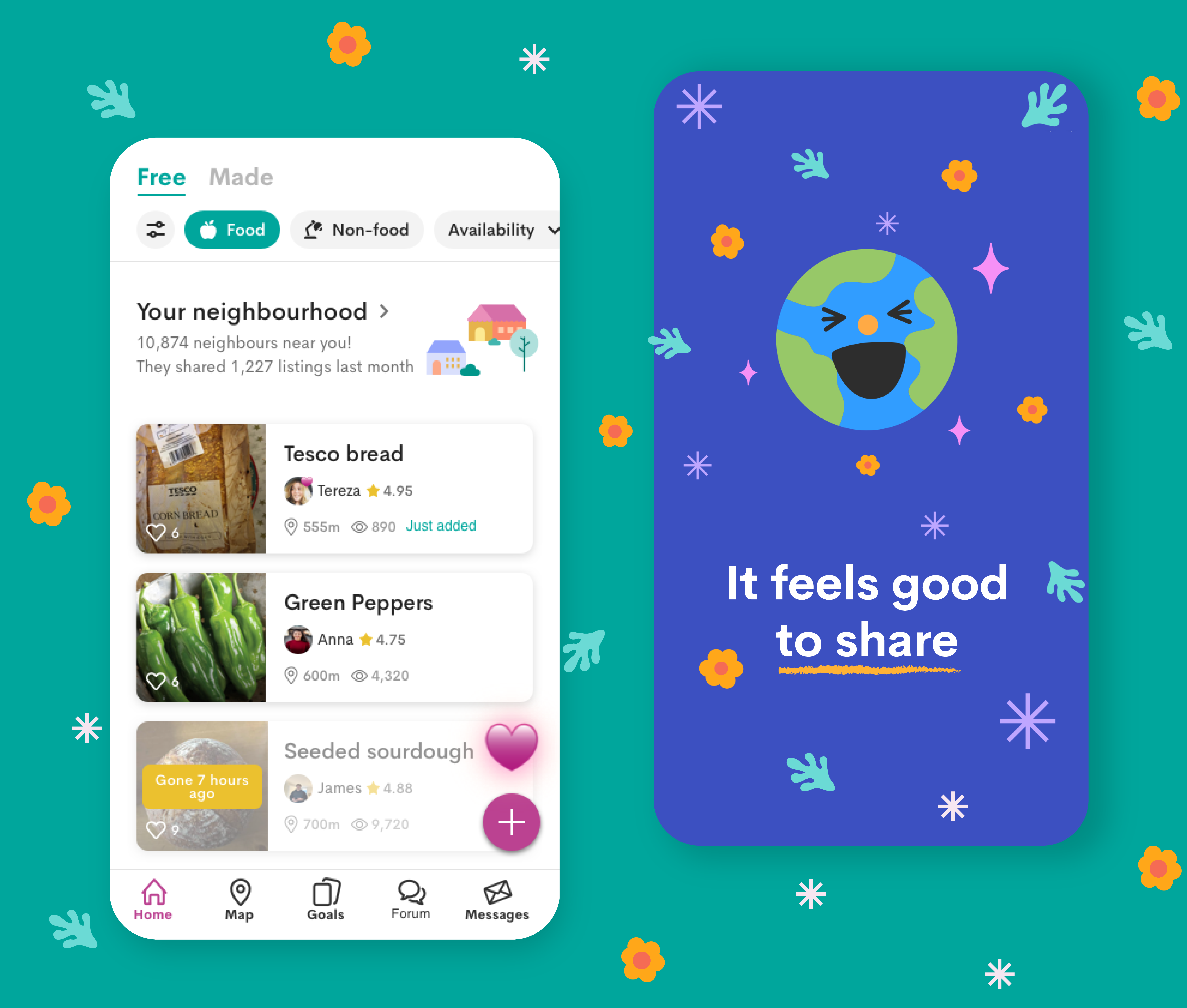
Description: Olio allows users to share any item, but emphasizes food, with their local community. Users can upload food items they’d like to give away, set pickup locations, browse listings, and request listings.
Audience: Anyone who has extra food items that they’d like to share with their community, especially those interested in mutual aid and sustainable living practices. There is an implied requirement that users must trust their community to share items safe for consumption as well.
Value add: By being community-based, Olio allows users to share within their local community beyond just their close circle, which may not engage in the same sharing practices or have the items a user is looking for. It provides an easy way to connect with other like-minded sustainability-focused people, who are interested in putting their ideals into practice. Also, nothing is listed for a price– users can find items for free instead of grocery shopping!
Strengths: Users can potentially see a wide variety of food items to choose from depending on the diversity of their community, which may also lead to discovering new ingredients, dishes, cultures, or friendships. Through the items’ photos, descriptions, and pickup location, users might have more agency in finding ingredients that fit their preferences.
Weaknesses: This depends on strong community trust, which studies have shown is harder to establish with food items. There does not seem to be any accountability or verifcation features as well, making it difficult to feel secure in whether other users’ items can be trusted, especially for consumption.
Takeaways: One person’s trash is another’s treasure– literally! It is important to consider how different communities might value what another community sees as surplus food: “waste” or “leftovers”. While thinking about how resources can be shared, it is just as important to consider how trust can be established as well.
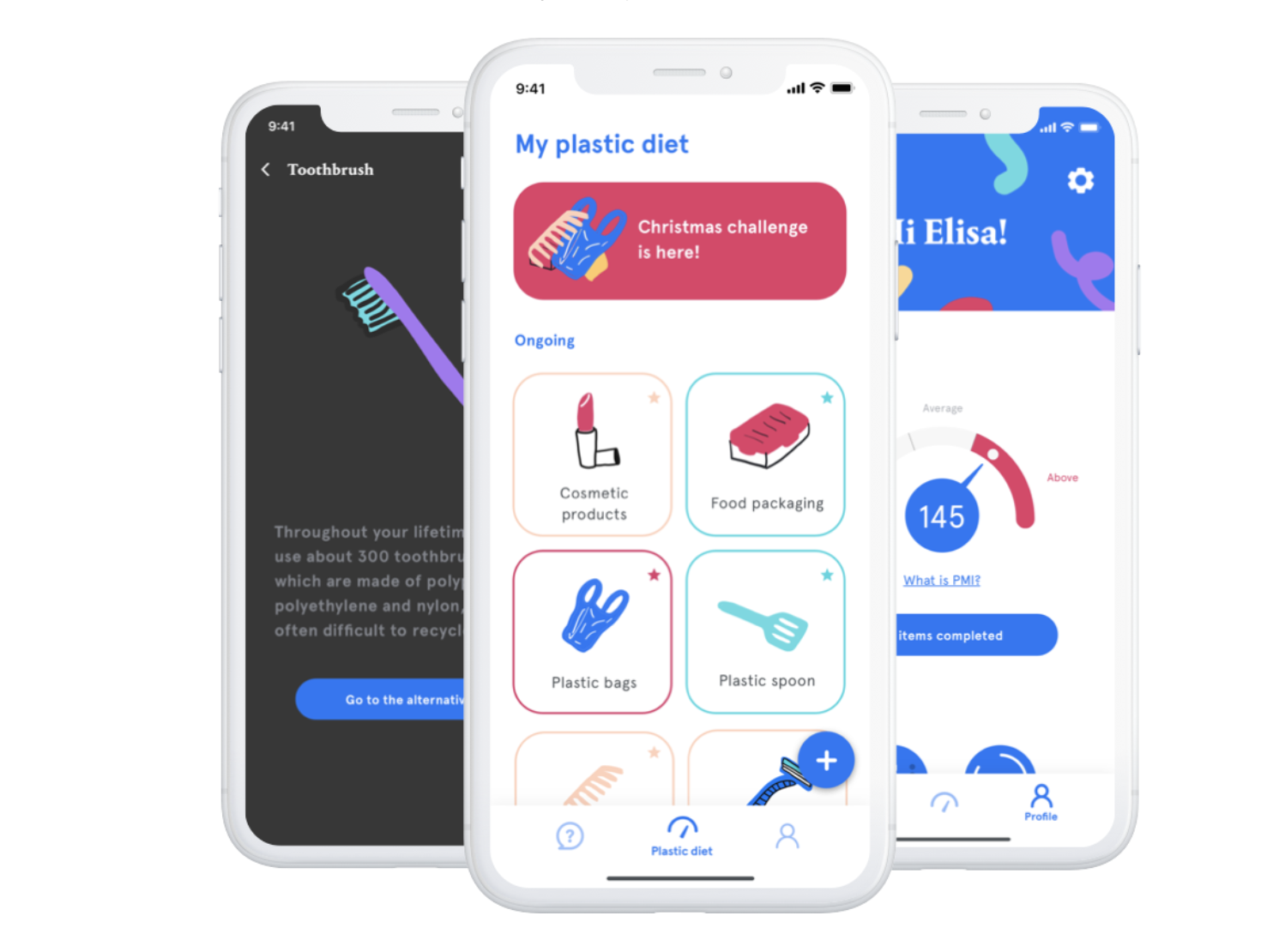
This app helps users track their “plastic footprint,” or amount of plastic waste. This could be analogous to helping users track another kind of waste, food waste.
Product Description: A gamified experience to tracking one’s real-life plastic waste, digitally. The app allows users to select an area of their life they would like to go on a “plastic diet” in, such as bathroom, kitchen, travel or leisure, and shows you your “Plastic Mass Index” as a metric for how much waste you produce. In addition, the app provides suggestions for alternatives to plastic and educates users.
Target Audience: Environmentally-conscious users who wish to reduce their plastic consumption and waste.
Strengths: The gamification aspect of the app allows users who are already eco-minded to reinforce their behavior in the real world. Users commented on how fun the app was to use to level up while learning more about ways they could reduce their waste and consumption. In addition, the ability to focus in on one area of life to reduce plastic usage helps keep the task at hand from seeming overwhelming.
Weaknesses: This app seems to take a highly varied approach to reducing plastic consumption, rather than honing in on one niche. This makes it challenging to describe the app to others besides “it helps to reduce waste” and may be a barrier to adoption. Despite large organizations backing and developing the app, it does not seem to have gained much traction over the 5 years it has been on the App Store.
Takeaways: Gamification can be one way to keep users engaged on the task at hand and connect the real world to the world of the digital app. In addition, the idea of the “Plastic Mass Index” and a central metric around which to optimize feels particularly relevant to food waste, as users of our app could work on reducing their overall food waste in grams/ounces. Having a score like that could encourage people to care more about the quantified amount of food they are wasting.
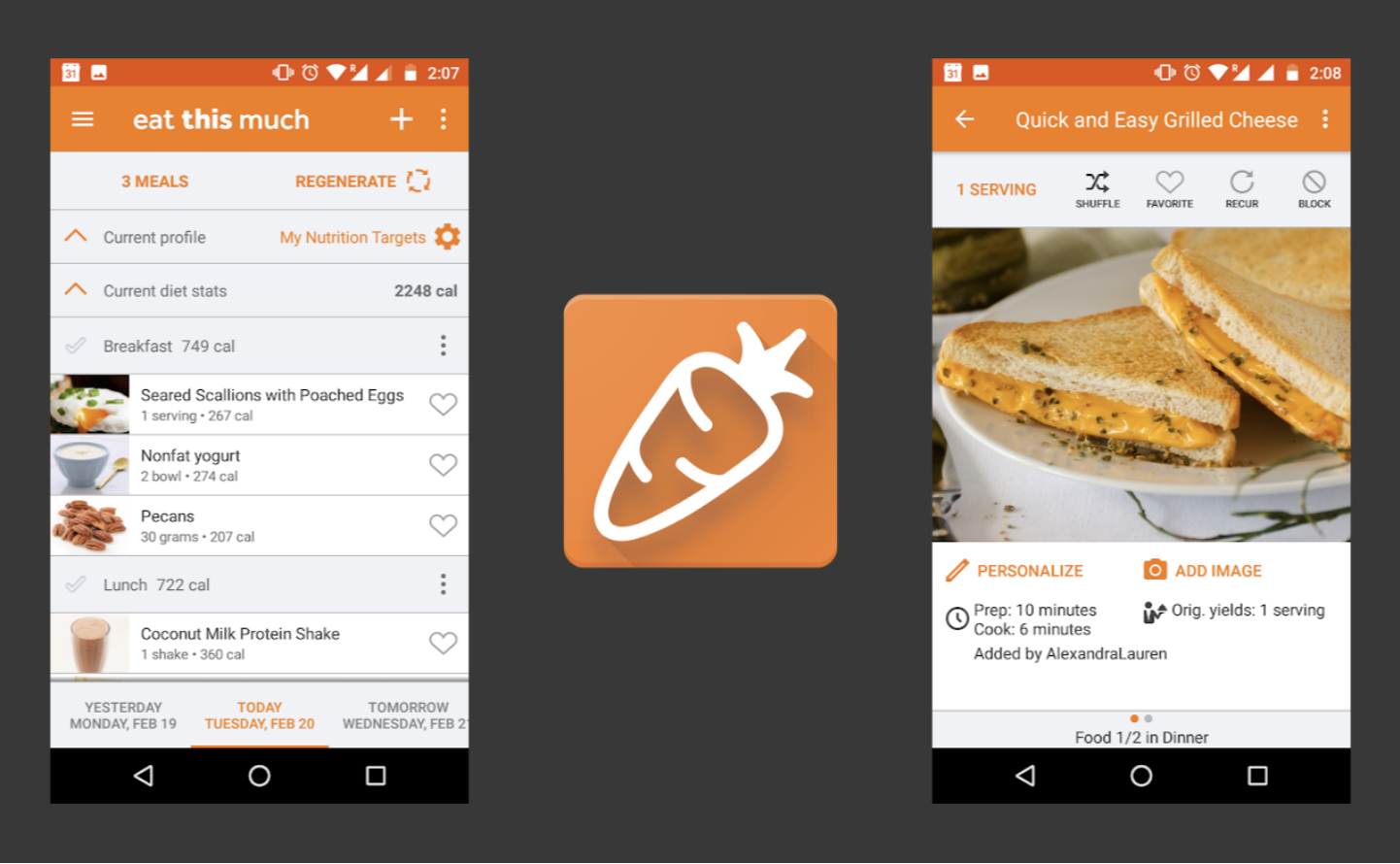
This app specifically addresses portion size in relation to weight loss. Although our problem space is not weight loss, selecting an appropriate portion size is an important factor in food waste.
Product Description: This app’s tagline is “put your diet on autopilot.” The app aims to use automation to design users’ diets according to their nutrition and fitness goals, helping them generate meal plans to help them stay healthy. As the app’s name implies, it provides instructions on portion size and menu item ideas.
Target Audience:
- People who already have nutrition goals they wish to meet, but do not have time to create their own meal plans.
- People who are not aware of how to meet their nutritional needs, who rely on this app to educate and create a guide for them.
- People who wish to lose weight but need more discipline (in the form of instructions) with their portion sizes and food choices.
Strengths: Unlike other food-planning apps, Eat This Much does not rely on users to individually log or input every food that was eaten, due to its uniquely prescriptive approach of generating meal ideas for its users. One strength of this app is the ability for users to track whether they deviated from the generated menu items, with the software automatically folding these new data points into the algorithm for future meal plans.
Weaknesses: The app recommends meals which are mostly American cultural foods; this lacks consideration for other cultures’ foodways and preferences.
Takeaways: Reducing portion size has been shown in our literature review to be one effective method in reducing food waste. Yet, everyone has different caloric needs and prescriptively enforcing one portion size for all is not user-friendly. Eat This Much provides a model for how to take user behavior into consideration in the algorithm while still providing guidance on a healthy amount of food to prepare/eat for each individual user.
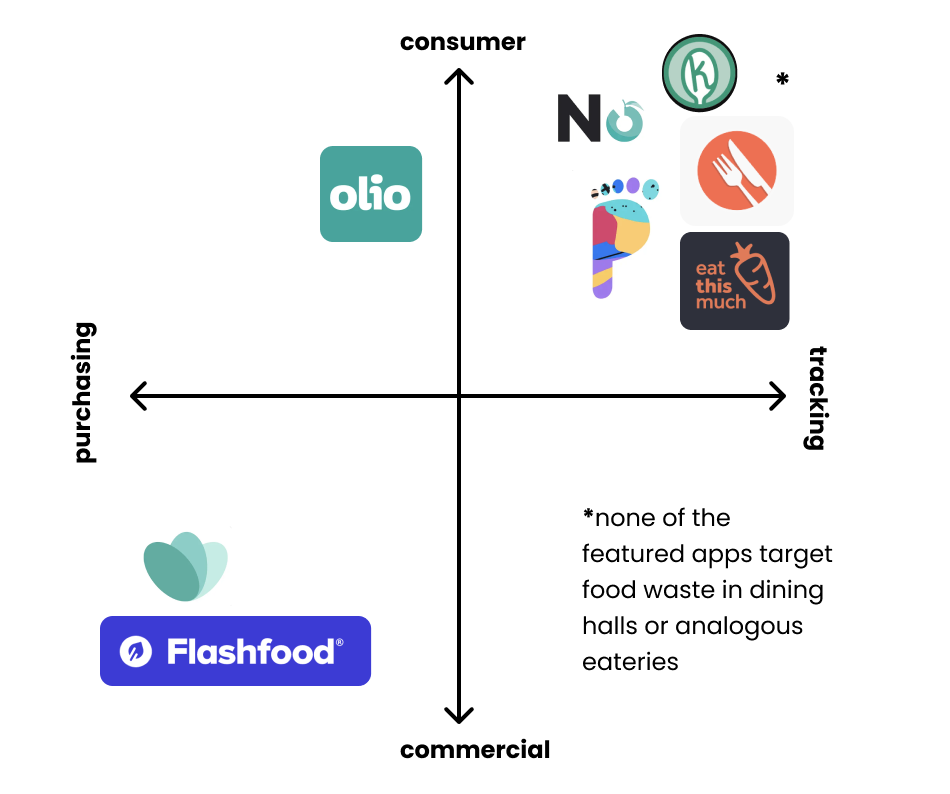
There is a large emphasis on how individual consumers can reduce their own food waste, though commercial food waste is arguably the bulk of the issue. Therefore, the saturated upper quadrant makes sense; it is understandable that the majority of mobile apps targeting food waste are designed for individuals. Some partner retailers with consumers to reduce commercial waste. However, none of these apps target food waste in dining halls or analogous buffet-style eateries. Our product will be the only app that tracks food waste by the individual plate.

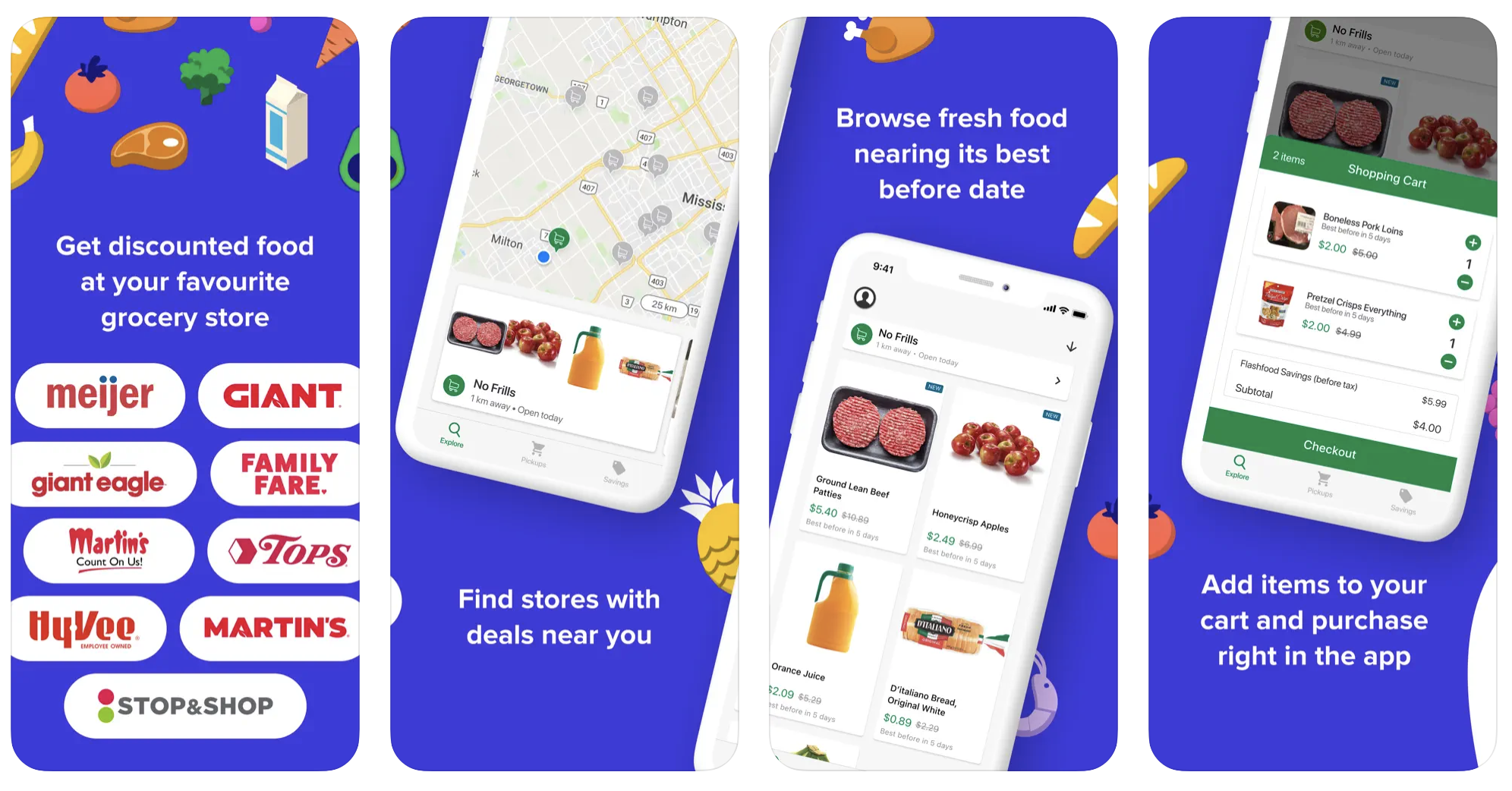 Flashfood
Flashfood